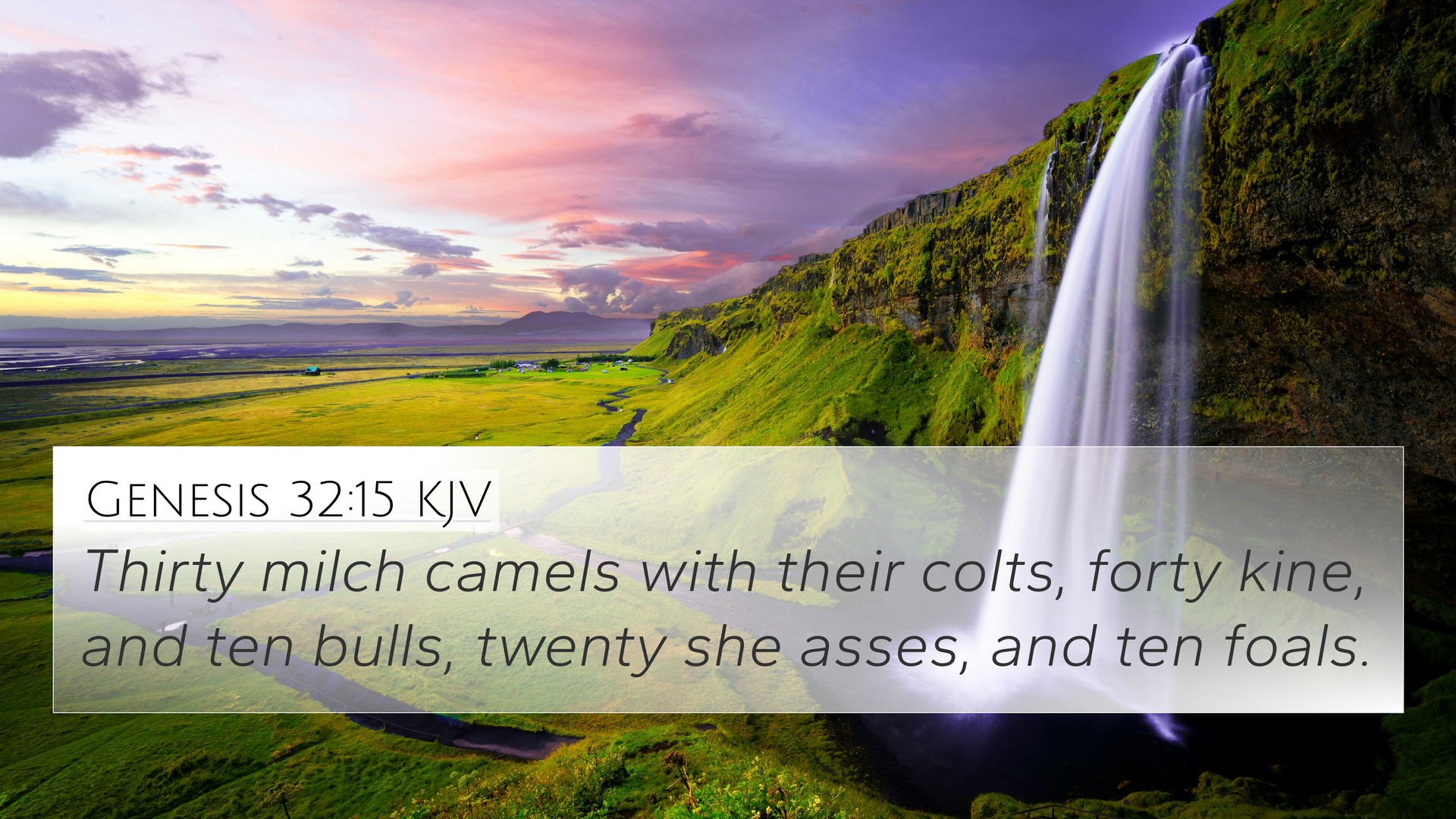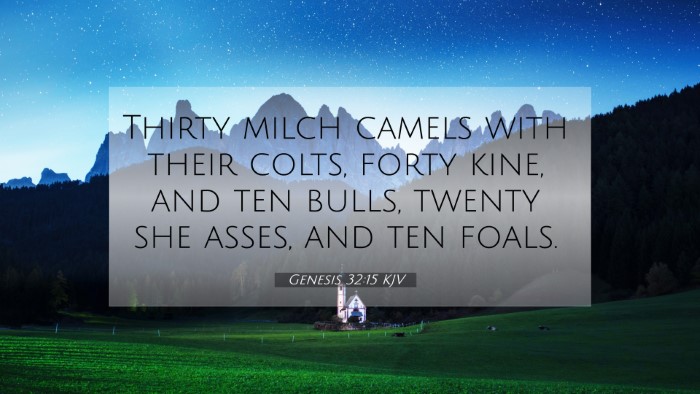Understanding Genesis 32:15
Genesis 32:15: "Thirty milch camels with their colts, forty kine, and ten bulls; twenty she asses, and ten foals." This verse belongs to a moment in Jacob's life when he was preparing to encounter his estranged brother Esau. Jacob, fearing for his safety, sends gifts ahead of him in the form of livestock to appease Esau.
Summary of the Verse's Meaning
In this passage, Jacob’s attempt to reconcile with Esau through generous gifts reflects themes of humility, reconciliation, and the importance of seeking peace in relationships. Additionally, it illustrates biblical principles surrounding the need to apologize and make amends for past wrongs. Jacob is concerned about his past actions and wishes to soften Esau's heart before their potentially dangerous meeting.
Insights from Commentaries
Matthew Henry's Commentary
Matthew Henry underscores that Jacob, while acknowledging his past deceit, exhibits an understanding of the necessity of humbling himself before Esau. The offering of gifts signifies not only repentance but also a strategy to demonstrate goodwill. The vast number of animals indicates his wealth and willingness to share, which is an act of service towards Esau.
Albert Barnes' Notes on the Bible
According to Albert Barnes, this display of generosity was a way for Jacob to demonstrate sincerity and a desire for reconciliation. The composition of the gifts—milch camels, cows, bulls, donkeys, and foals—symbolizes abundance and the extent of Jacob's commitment to restoring his relationship with Esau. Barnes also highlights that these gifts served as a means of addressing Jacob's fear, reflecting the importance of material expressions in maintaining relationships.
Adam Clarke's Commentary
Adam Clarke points out the strategic nature of Jacob's actions, elaborating that the gifts were to be presented in waves, emphasizing the intention to create a lasting impression on Esau. Clarke's insights further stress the idea that reconciliation efforts often require humility and sacrifice, portraying the relational dynamics beautifully exemplified in Jacob's actions.
Thematic Connections in Scripture
This verse doesn’t stand alone; it connects to various themes throughout the Bible, which can be understood through scriptural cross-referencing.
- Proverbs 18:16: "A man's gift maketh room for him, and bringeth him before great men." This verse highlights the importance of gifts in relation building and reconciliation.
- Genesis 33:4: "And Esau ran to meet him, and embraced him, and fell on his neck, and kissed him: and they wept." This verse shows the result of Jacob’s efforts and the reconciliation between brothers.
- Romans 12:18: "If it be possible, as much as lieth in you, live peaceably with all men." This reinforces Jacob's approach to reach out for peace.
- James 4:10: "Humble yourselves in the sight of the Lord, and he shall lift you up." This illustrates the biblical principle of humility before God and others, a theme evident in Jacob's actions.
- 1 John 4:20: "If a man say, I love God, and hateth his brother, he is a liar." The need for reconciling love is emphasized.
- 2 Corinthians 5:18: "And all things are of God, who hath reconciled us to himself by Jesus Christ, and hath given to us the ministry of reconciliation." This address the Christian call to seek reconciliation.
- Matthew 5:23-24: "Therefore if thou bring thy gift to the altar, and there rememberest that thy brother hath ought against thee, leave there thy gift before the altar, and go thy way; first be reconciled to thy brother." This confirms the biblical priority of reconciliation before gifts.
Conclusion: Lessons from Genesis 32:15
Genesis 32:15 serves as an important reminder of the complexities of relationships and the steps one may take towards reconciliation. The lessons learned from Jacob’s approach through gifts and humility encapsulate the biblical themes of repentance and the quest for peace.
Further Thoughts on Cross-Referencing
For those seeking deeper understanding of scriptural connections, utilizing tools such as a Bible concordance or a bible cross-reference guide can enhance one's study. Proper cross-referencing can illuminate inter-Biblical dialogues and thematic connections in Scripture, bridging insights across the Old and New Testaments.
Suggestions for Cross-Referencing Study
- Explore how Old Testament narratives connect with New Testament teachings using cross-reference Bible study methods.
- Identify connections between Bible verses to enrich your understanding of God’s overarching message.
- Utilize Bible reference resources for a comprehensive examination of related themes.
- Learn about Bible cross-reference systems to effectively navigate scriptural relationships.


